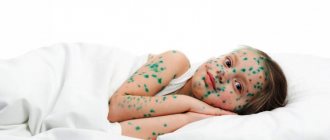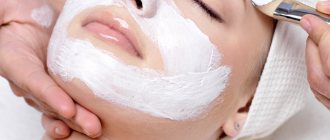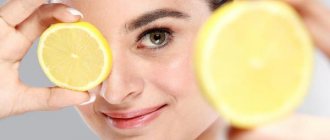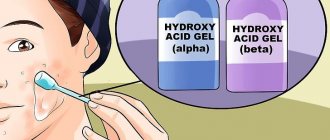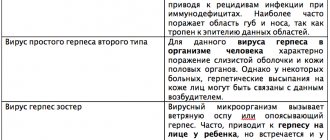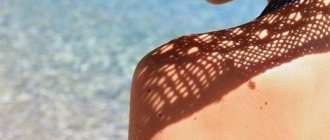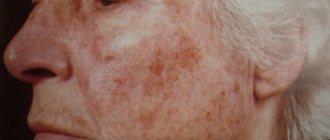In case of pityriasis versicolor formation, antifungal therapy is prescribed. If the disease is at the initial stage of its development, then special antifungal ointments are prescribed, which are used locally. If the disease is already advanced, local and systemic antimycotic drugs will be used.
White pigment spots on the face
The appearance of snow-white pigment spots on the face may be completely unrelated to infections in the body. Let's look at the most common of them.
If babies develop snow-white spots, then this is most likely a manifestation of hypomelanosis.
This is a pathological condition that manifests itself in the form of dyschromia of the surface layer of the skin.
This often occurs in babies already in the first months or years of life, and hypomelanosis, in turn, is preceded by severe infectious diseases. In addition, the mechanism of development of this pathological condition is still not known, and in some cases it is accompanied by damage to the central and peripheral nervous systems, which can affect the overall development of the baby. To eliminate specifically the skin manifestations of hypomelanosis, drugs are prescribed that are derivatives of retinoids and help slow down the rate of spread of skin changes. In addition, you can use special peeling.
In adults, the formation of snow-white spots occurs after suffering from certain viral diseases - this is how Zhiber’s lichen appears.
How the primary maternal plaque develops and how it spreads throughout the body is still unclear. The source of the disease can form in any place of the body, and from it screenings spread throughout the body. These screenings look like small depigmented areas, truly limited from healthy skin, but when pressed they are completely painless. But not everything is as scary as it looks at first glance. Such spots will disappear after some time without the help of others, and to speed up this disappearance, the modified areas of the skin can be treated with an alcoholic substance with salicylic acid.
The most common cause of white spots is skin depigmentation, which is called “Vitiligo”.
This disease destroys malanocytes, which are located in the thickness of the skin, as a result of which its areas become covered with spots of milky white or light pink color. As a rule, the skin of the hands, knees and face is affected by this change.
When spots appear, there is no subjective feeling, but a few days before they form, the skin may itch or itch.
Vitiligo is a disease that occurs due to:
- severe viral diseases and immunity disorders;
autoimmune diseases;
How to remove white spots on the face of a child and an adult
White dots often appear on various parts of the face, localized in the area of the lips, sinuses, and around the eyes. Small growths of this type may appear not only on skin prone to oiliness.
The main prerequisite for the formation of snow-white nodules can be considered a disruption of the normal functioning of the sebaceous glands.
With improper treatment and illiterate use of cosmetics, white spots can affect healthy areas of the skin, rapidly increasing in volume.
Treatment
Scientists have not yet been able to develop a pathogenetic treatment. Therefore, treatment is carried out only at the symptomatic level. The main task is generalization and reduction of manifestations.
For treatment, corticosteroid medications are used directly on the lesion. They also talk about the effectiveness of topical retinoids, pimecrolimus and cryomassage.
Sometimes photochemotherapy is used, as well as methods of replacing melagenin with the drug.
If necessary, bioresonance therapy is used, which should restore normal functioning of the nervous system and improve immunity.
Reasons for appearance
The appearance of unaesthetic snow-white spots on the face is associated with the dysfunction of the sebaceous glands. Excessive sebum production clogs the pores and hair follicles, resulting in a whitish nodule.
Often, dermatologists call the reasons for this imbalance of the skin the primary signs of a violation of the proper functioning of the body:
- hormonal imbalances;
- progressive skin diseases (seborrhea);
- pathology of the heart muscle;
- diseases of the liver, gall bladder;
- intestinal disorders;
- disorders of the vascular system;
- elevated blood cholesterol levels.
In addition, there are often cases of hereditary predisposition to this disease, as well as the influence of exogenous causes.
Among the external circumstances, the following can be distinguished:
- lack of adequate personal hygiene;
- incorrect selection of cosmetics for facial care;
- excessive exposure to ultraviolet rays;
- unbalanced diet;
- presence of bad habits;
- long-term living in poor environmental conditions;
- frequent injury to the skin;
- insufficient oxygen consumption;
- long-term use of potent pharmaceuticals.
When consulting a dermatologist, you should definitely find out the nature of the disease, so the formation of white spots can be provoked by both internal and external factors.
Classification of Snow White Hard Points
Small whitish formations on the skin of the face differ from each other in the presence of internal contents, as well as the system of formation of parts of the disease.
Thus, we can distinguish certain types of these neoplasms:
- Functional sebaceous cysts. A neoplasm or atheroma occurs in the ducts of the sebaceous glands and resembles a small sac filled with keratin. Cysts appear at any age, even in infants they can form from non-living tissue of the epidermis. Cysts are capable of combining into several chambers, forming a growth with two or three membranes. Micro cysts are localized in areas of the face with high fat content.
- Wen or milia traditionally populate the areas around the eyelids and cheekbones.
Such formations are visually similar to atheromas, but they are formed from fat cells and the secretion of the sebaceous glands. Some wen can form in the deepest layers of the dermis, but upon palpation they do not cause pain, having a flexible outer layer. - Pseudomiliums represent an increased concentration of sebum in the deepest tissues, which is why they are traditionally formed at the site of scars, scars and in places of the injured layer of living cells. Often, infection with bacterial microorganisms occurs as a result of self-opening of acne or scratching the skin. From the outside, the skin of the face looks lumpy.
- White pigment spots appear at any age.
Often they transform into snow-white dots, but they are completely flat and are related to the dysfunction of neuroendocrine regulation.
Only a qualified specialist can diagnose the presence and type of pathology affecting the skin, so you should not try to eliminate neoplasms without the help of others in order to avoid future unnecessary skin infections.
It will be easier to choose an ultrasonic facial cleansing device after reading our publication.
You can read how to perfectly braid a braid in this article.
From here you will learn how to make the deepest bikini at home.
Elimination methods
How to get rid of snow-white spots on the face?
If an excessive number of such wen appears on the face, they can be eliminated in various ways:
- The use of bactericidal ointments for the formation of small inflamed lesions (“Erythromycin ointment”, “Clindamycin ointment”, “Dalacin” gel).
- The use of drugs aimed at reducing the secretion of the sebaceous glands (Skinoren Gel, Boro Norm cream, ointments based on zinc and tar).
- When large areas of skin are affected, ointments with retinoids are used (Klenzit S gel, Differin).
- Go on a special diet that limits fatty foods and regular carbohydrates.
Instead, your daily diet should include the following foods:
- boiled vegetables;
- dairy products;
- light protein dishes;
- taking vitamin-mineral complexes.
Elimination of spots using cosmetic procedures traditionally includes various programs for cleaning the epidermis:
- mechanical;
- ultrasonic;
- photoradiotherapy;
- vacuum;
- peelings (acid, microdermabrasion);
- laser resurfacing.
The use of mechanical surgical methods for removing snow-white formations:
- cryotherapy (using watery nitrogen);
- laser coagulation (the most gentle removal method, suitable even for children);
- radiosurgical removal (excision of growths without leaving scars);
- electrocoagulation (use low-frequency electric current).
Not all types of white spots can be easily eliminated with the help of medications, which is why patients are increasingly resorting to surgical or mechanical removal of the formations.
The fight against white spots
There are a number of cosmetic products that can treat these spots and restore the original appearance of the skin. Common products are whitening masks and cosmetic peels, which are based on lactic or citric acid. However, most beauty salon clients prefer to resort to the following procedures:
- Photochemotherapy. The procedure involves exposure to light rays, due to which the number of melanocytes begins to increase. This causes the destruction of melanin present in the skin and accelerated synthesis of a new substance. The affected area is completely filled with the required pigment after an average of 10 sessions of the cosmetic procedure.
- Plasmolifting. This procedure involves the injection of the patient’s plasma into the damaged parts of the skin. This helps to increase the concentration of platelets in the affected area. They have a positive effect on the restoration processes of stem cells. At the same time, melanin synthesis increases and the normal functioning of melanocytes is restored.
- Laser treatment. During this procedure, depigmented parts of the skin are treated using a powerful laser beam. Under its influence, the activity of T-lymphocytes, which have a destructive effect on melanin and reduce its content in the skin, decreases.
- Bleaching. This process stops the contrast between healthy skin and depigmented areas of skin. Monobenzone is used during this procedure.
- Skin grafting. This is an exceptional measure that is used in extreme cases when less radical methods do not help. It is a surgical intervention during which the damaged area of the skin is filled with microscopic areas of healthy skin.
Traditional medicine
In order to reduce inflammation, disinfect the skin and prevent the formation of new nasty growths on the face, you can use non-standard medicine.
Traditionally, folk recipes provide masks and compresses that eliminate excess skin secretions.
Ways to remove whiteheads on the face using folk remedies:
- masks made from cosmetic snow-white or blue clay are diluted with water and lemon juice, applied twice a week for 30 minutes;
- a mask made from egg whites and kefir perfectly opens and cleanses pores;
- the yeast mask consists of honey, hydrogen peroxide, lemon and brewer's yeast, which must be mixed in equal proportions (one teaspoon each);
- a herbal anti-inflammatory compress is prepared from chamomile and calendula plants (a tablespoon each), steamed with hot distilled water;
- pumpkin mask with the addition of nettle (oatmeal and a tablespoon of steamed nettle leaves are added to the pulp of 2 small pieces of pumpkin) applied for a minute;
- cool washes before bed with natural yogurt or chilled chamomile infusion.
However, you should definitely keep in mind that the use of traditional recipes is not suitable for everyone.
White spots on the face of a newborn
The formation of snow-white spots on the face of infants is a fairly common phenomenon.
What do snow-white dots on the face of a newborn baby mean?
Most often, there are two main types of neoplasms:
- Milia occurs due to the beginning of active work of the child’s sebaceous glands. A very large secretion production clogs the pores, forming small tubercles that can dissolve over time.
- Infant acne is formed under the influence of the mother's hormonal levels when the baby is still in the womb.
Snow-white dots of this type do not need to be cured; they can disappear on their own once the child reaches months of life. But the baby’s skin needs to be cleaned (washed) and carefully dried with a sterile cloth.
How to remove (remove) snow-white spots on a child’s face? If the snow-white formations do not bring discomfort to the child, do not change shape and do not become inflamed, then they should not be cured.
Parents, taking care of their child, often begin to wipe the formations with alcohol solutions or try to remove them without the help of others. But this is prohibited to avoid infection of healthy epidermal cells.
As for older children, the milia that form in them can disappear naturally as a result of the renewal of the layers of the epidermis.
In addition, you should slightly adjust the child’s diet, eliminating very fatty foods.
With the advent of adolescence, white spots begin to create mental discomfort, so you should consult a dermatologist. Traditionally, dermatologists give the following methods for removing formations:
- manual removal using sterile instruments;
- laser removal;
- by electrocoagulation method.
Before you dare to remove spots, you can try to eliminate skin imperfections with the help of cosmetics. You also need to realize that the period of adolescence constantly entails hormonal changes in the body.
Vitiligo
One of the most likely causes of the formation of light areas on the skin is the disease vitiligo. When it occurs, the skin does not produce a sufficient amount of melanin; under favorable conditions, discoloration of some areas of the epidermis occurs.
Typically, the disease begins to activate under the influence of ultraviolet radiation, and it can also be triggered by stressful situations. It is worth noting that this disease does not have any other symptoms.
The only thing is that some people may experience discomfort associated with external manifestations. In most cases, spots appear on the face and neck.
Vitiligo is an acquired disease. The spots are most often white or colorless; they can be of completely different sizes, and over time they can begin to increase. Also, light hairs will grow in such places.
It usually occurs in children and young people.
Preventing snow-white formations on the skin
In order to prevent the appearance of snow-white spots on the face, you should adhere to certain rules of facial care, as well as watch your health and diet:
- thoroughly cleanse the skin day and evening;
- select personal cosmetics for facial care;
- refuse to use products with harsh chemical effects on the skin;
- Always remove any remaining makeup before going to bed;
- try to touch your face with your hands as little as possible;
- do not use expired cosmetics or low-quality products;
- eliminate bad habits;
- seek help from a specialist in case of minor ailments;
- monitor the proper functioning of the intestines;
- strengthen the immune system;
- more often be in natural areas enriched with oxygen;
- exclude heavy carbohydrate foods, fatty, smoked, spicy foods from the diet.
Spots and rashes due to parasitic diseases of children: causes and treatment
Even the smallest children can be susceptible to parasitic diseases. They develop due to the penetration of parasites onto or under the skin. Due to irritation in response to the vital activity of creatures, a rash and redness may appear on the child’s body. Among these diseases are:
- Pediculosis
- Lichen
- Scabies
- Demodicosis
- Helminthiasis
There are also other (rare) diseases. To prevent the development of parasitism in the child’s body, it is necessary to select a comprehensive treatment led by a specialist from a medical institution. Only a doctor can prescribe treatment for this degree of disease. This process should not be delayed.
White pimples on a baby's face are not a problem!
The birth of a baby is a small magic, endless joy and worries.
The baby's skin is traditionally warm and smooth. Any changes that occur on it force one to worry about the state of his health. Most often, parents are worried when they see snow-white pimples on the face of a newborn, which appear within 2-3 weeks after birth.
Such an incident causes not only concern, but also bewilderment: what happened? Why did they appear? After all, the baby was fully looked after: washed, bathed. Pediatricians say that snow-white pimples on a baby’s face are a common phenomenon associated with the adaptation of the child’s body to the new environment of existence.
There is no need to be afraid of them. They are not unsafe and go away on their own, do not require healing and do not tolerate intervention. You can take photos of this phenomenon by reading our article.
Allergy white spots
What causes white spots on the skin of the face, how to treat them? Is this a concern? Changes in skin color are common, especially on the face. Some people develop red spots from acne, while others may develop dark-colored spots.
You may notice white patches appearing on your cheeks or elsewhere on your face. Sometimes these spots can cover a large surface area and can even spread to other parts of your body.
A number of conditions can cause white patches to appear on your face, and they are usually not a cause for concern. Here's a look at the most common causes and how to fix them.
Milia
Milia develops when keratin gets under the skin. Keratin is a protein that makes up the outer layer of skin. This causes tiny white cysts to form on the skin. This condition most often occurs in children and adults, but can also occur in newborns.
When white spots are caused by trapped keratin, the condition is called primary milia. However, these tiny white cysts can also form on the skin as a result of a burn, sun exposure, or poison ivy. Cysts may also develop after a skin resurfacing procedure or after using a topical steroid cream.
Milia can develop on the cheek, nose, forehead and around the eyes. In some cases, cysts form in the mouth. These bumps are usually not painful or itchy, and the condition usually resolves without treatment within a few weeks.
If your condition does not improve within a few months, your doctor may prescribe topical retinoid cream or recommend microdermabrasion or other medications to repair damaged skin. Your doctor may also use a special tool to correct discoloration of the skin.
Pityriasis alba
Pityriasis alba (Pityriasis alba) is a type of eczema that causes a splintered, oval patch of discolored white skin to appear. This skin disorder affects about 5 percent of children worldwide, primarily between the ages of 3 and 16 years.
The exact cause of this pathology is unknown. The disease is usually observed according to the type of manifestations of atopic dermatitis. It may be due to sun exposure or yeast, which causes hypopigmentation. Pityriasis alba often clears itself within a few months, although the discoloration can last up to three years.
If you experience symptoms, apply moisturizer to any dry patches and use a corticosteroid such as hydrocortisone, which has an anti-inflammatory, anti-allergic effect and relieves any itching or redness.
Pityriasis versicolor during pregnancy
A pregnant woman's body experiences many changes during pregnancy, including skin changes. In addition to developing dark spots, stretch marks and acne, in some cases these women develop pityriasis versicolor. This is generally not a cause for concern. Skin color usually returns when hormone (estrogens) levels return to normal.
If you want to quickly eliminate any blemishes that may appear on your skin, contact your doctor for an antifungal medication that is safe to use during pregnancy.
Idiopathic guttate hypomelanosis (sun spots)
Idiopathic hypomelanosis, or sun spots, are white spots that form on the skin as a result of prolonged exposure to ultraviolet radiation. The number and size of the white spots vary, but they are usually round, flat, ranging in size from 2 to 5 millimeters. These spots can develop on different parts of the body, including your:
This condition is more obvious in people with fair skin; your risk of sun spots increases as you age. Women often experience spots at an earlier age than men.
Since these white spots are caused by UV radiation, you should use sun protection to prevent sun spots from getting worse. This may help you prevent new lesions from forming.
Source: https://kozhnye.ru/allergija-belye-pjatna.html
Causes of snow-white pimples in newborns
The manifestations of milia (white pimples) are similar in all children, but the reasons for their occurrence may be different. Among them are:
- Hormonal changes in the child's body.
Such pimples appear immediately after birth. These are so-called postpartum acne. - Excess of the female hormone estriol. It enters the baby’s body during pregnancy by the mother, if she had an excess level of it. A rash in the form of snow-white pimples appears on the day after birth, can have a yellow tint, and can be located either singly or in groups.
- Insufficient formation of the baby's sebaceous glands.
Milia most often occur on the nose, cheeks, and forehead. Less often - on the baby’s bottom. The sebaceous ducts become clogged with excess sebum and gather into lumps, which we see as snow-white millet pimples. They disappear as the sebaceous glands mature (after about a month or two).
The main sign that there is milia on the face of an infant is the absence of an increase in temperature, normal sleep and appetite.
Elimination of snow-white pimples in newborns
Milia by themselves do not cause any problems for the baby. They disappear without a trace after some time. But parents are still interested in the question: “How to remove pimples from my child’s face?”
There are some tips that you can follow to speed up the disappearance of unaesthetic spots.
- Provide the child with appropriate hygiene procedures. Once a day, wipe his face with warm water or furatsilin, bathe once a week in a weak solution of manganese or in water with the addition of herbs: string, chamomile. In the first months, bathe your baby without soap.
- Attention: wiping with alcohol and squeezing out pimples on your baby’s face is strictly prohibited!
There are no other measures to combat milia. If following the advice does not help and snow-white pimples remain on the baby’s face, you need to consult a dermatologist to identify and eliminate the circumstances of their appearance.
Other types of acne in children
A baby under one year old may have many different pimples, moles, and spots on his body.
They are not always snow-white. For example, in hot weather the baby sweats and develops heat rash, which goes away after 1 or 2 baths.
At about two months, the baby begins to “bloom”, associated with hormonal changes in the body. It appears as redness on the face, back and chest.
Miliaria and flowering are not unsafe, and go away without the help of others. But there are also the least safe rashes, which we will look at further.
Rashes that are a manifestation of the disease:
- Small snow-white pimples, pustular in nature, indicate vesiculopustulosis.
They can appear anywhere, even on the baby’s head. The cause is staphylococcal infection. Treated with brilliant green or strong potassium permanganate. They require treatment from a doctor. - Blistering pimples with a reddish halo may indicate the presence of herpes or chickenpox.
- Diseases of the intestinal tract are observed against the background of rashes (dysbacteriosis).
- Measles, rubella, scarlet fever, and allergies are accompanied by patchy rashes.
- Red pimples with white ends may be a sign of furunculosis.
The main symptoms of the disease are not the subcutaneous pimples themselves on the face of babies, but the baby’s lethargy, weakness, drowsiness, fever, and moodiness.
Spots and rashes due to infectious diseases: causes and treatment
Infectious and parasitic diseases can often signal their development in the form of spots. It’s impossible to count the entire list of diseases (chickenpox, rubella, measles, scabies, pseudotuberculosis and yersiniosis, felinosis, erythema infectiosum, scarlet fever, roseola, sudden exanthema, herpes infection, infectious mononucleosis, molluscum contagiosum, meningococcal infection, enteroviral vesicular stomatitis and others) . With these diseases, spots may appear immediately, then other accompanying signs of the disease appear. For example, chicken pox
Or white and red formations may appear a few days after the onset of the disease. For example, with measles, red spots appear on the body on the 3rd day.
Many spots at the initial stage of formation do not cause significant concern. But if you are not careful, this can play a cruel joke on the child. If an infectious disease is detected, treatment with drugs and medicines is carried out strictly under the supervision of a doctor.
In older children
The occurrence of acne in a boy or teenage girl is not surprising or alarming.
Hormonal changes lead to the formation of reddish infiltrates, dark acne or snow-white dense pimples on their face.
When acne attacks younger children, this phenomenon brings surprise and concern for their health. We saw newborn acne. If the child is one year old, and what was thought to be milia has not gone away, you should take the baby for a consultation with a dermatologist to clarify the reasons.
Acne in a 3-year-old child who has started going to kindergarten may indicate an allergic reaction or be a sign of an incipient infection.
At three years old, pimples with a snow-white core inside appear when Staphylococcus aureus is present in the body.
The conclusion that a child is sick with some of the above should be made by a specialist. He also prescribes healing. When it comes to your baby's health, self-medication is unacceptable. It will be extremely useful to read an article on how to strengthen a child’s immunity.
How to make a diagnosis
Such a reaction of the body may indicate the presence of serious diseases, so the diagnosis should be taken seriously. Make sure you find a truly qualified professional.
It is not always possible to make a correct diagnosis visually, so insist on getting tested. In such cases, it is recommended to undergo the following tests:
- Examine the liver;
- Ensure that the gastrointestinal tract is functioning properly;
- Check the bile ducts;
- Find out if there are helminths in the body.
Only after all these examinations can we talk about something concrete. Also, do not forget to visit a dermatologist, sometimes white spots on the skin are nothing more than pityriasis versicolor.
general description
White dots on the face, which are called milia, have the popular name of millet.
They look like snow-white nodules, similar to millet grains. When pressed, you can feel their density.
Rashes appear on any part of the face. This could be the lips, chin, eye area, cheeks or forehead. Condensed spots often appear in children during adolescence.
They are formed as a result of the accumulation of sebaceous secretions of the subcutaneous layer. Similar manifestations are more often observed in babies with oily or combination skin.
Condensed points are already clogged pores.
It is impossible to squeeze out sebum from them. Therefore, you should not try to get rid of rashes using a mechanical method. This will only lead to skin inflammation. You won’t be able to get rid of them even if you try to pick them out with a needle or tweezers. Such actions can become a prerequisite for infection, and the cosmetic defect of a compacted point will turn into a serious problem for the child.
Causes
In order to decide how best to get rid of rashes on your baby’s face, you need to find the cause of their occurrence.
Snow-white spots can form under the influence of various reasons, the main of which are:
- Excessive production of sebaceous glands, which occurs when there is a lack of zinc in the body;
- Impaired metabolism;
- Pathology intertwined with intestinal function;
- Incorrectly selected personal hygiene products;
- Increased blood cholesterol levels;
- Climate change, unfavorable environmental living conditions.
White spots on the baby's body can be prevented if certain recommendations are made.
Facial skin requires painstaking care.
For your baby, you need to choose a product that will match his age and skin type. It is necessary to cleanse your face daily.
Any skin type requires hydration, especially if it is problematic. A child should not be allowed to experience dryness of the facial skin from childhood.
When taking a shower, you need to steam problem areas, and after applying detergent, wipe them with a washcloth. This procedure will get rid of fat deposits and remove non-viable cells. After aqua procedures, the baby’s skin must be wiped with lotion. It must have drying properties.
Whiteheads in babies
Skin rashes are not only common for middle-aged children.
They often occur in newborns, which refers to physiological manifestations.
Small dots that look like small tubercles appear on the baby’s face from the first days of his life. If the manifestations are not accompanied by inflammation, they do not bother the baby. There are several main reasons that influence the cause of education.
Hormonal changes in the baby's body. The spots appear from the first days of a baby’s life, during the period of adaptation of the body to new environmental conditions.
The influence of the female hormone on the baby. It penetrates into the baby's body during pregnancy. After birth, in the first week of life, snow-white dots may appear on the face of a newborn baby.
From time to time they have a yellow tint, and are placed singly or in groups.
Insufficient formation of sebaceous glands. Rashes most often occur on the baby’s cheeks, nose, or forehead. Excess sebum clogs the sebaceous ducts, which leads to the formation of compacted pimples.
It is not necessary to take measures to get rid of rashes. The baby's skin is cleansed after the sebaceous glands are fully restored. Traditionally this occurs by three months of age. The main signs that skin manifestations do not bother the baby are normal temperature, regular sleep and appetite.
Every mother must know how to care for her baby so as not to harm his health.
It is necessary to wash your baby from the first days of his birth. The procedure is carried out by wiping the face with boiled water at room temperature.
A decoction of chamomile or string is added to the baby’s bathing water. The pharmaceutical solution helps cleanse the skin and prevents the development of possible inflammation.
It is recommended that baby clothes be made from natural fabrics.
To prevent the child from damaging problem areas of the skin on his face, he is wearing protective gloves. Ultraviolet rays have a beneficial effect on the condition of the skin. Therefore, long walks are beneficial for the baby.
Recommendations for parents that should definitely be done if their baby has skin rashes:
- It is strictly forbidden to try to squeeze out white dots;
- Rashes cannot be burned with brilliant green or wiped with alcohol;
- The use of ointments and baby lotions, which can dry out the baby’s skin, is not recommended;
- By applying powder to problem areas of the skin, the pores close even more, which can lead to the onset of an inflammatory process.
A newborn baby who has snow-white rashes does not require special treatment.
Correct care and mother's care will help you get rid of them.
Treatment
Every person, having discovered unnecessary manifestations on his face, tries to get rid of them. Any rash not only spoils a person’s appearance, but also does not allow the cells to function one hundred percent.
The following will help adults and children get rid of the problem:
- Drying anti-inflammatory ointments,
- Treatment procedures performed by professional professionals in beauty salons;
- Use of cleansing masks at home;
- An established diet that enriches the skin with essential vitamins and microelements.
To get rid of skin manifestations, experts advise using ointments that contain lactic and salicylic acid, tar, and zinc.
They have not only drying properties, but also anti-inflammatory properties.
The action of the ointment helps to improve blood circulation in the cells of the skin, and this speeds up the tissue healing process. Apply the medicine to clean facial skin pointwise.
The procedure is carried out up to 3 times a day.
The most common pharmaceutical products that help get rid of rashes include ointments based on:
- Salicylic and lactic acid: “Dermosal-D”, “Sintomycin”, “BIOcon”;
- Zinc: “Zinocap”, “Desitin”, “Sulokrem”;
- Tar: “Sinoflan”, “Yam”, “Birch tar”.
Commonly used remedies for treating whiteheads and purulent pimples include Metrogyl gel, Dalatsin, and Gentomycin ointment. For widespread rashes, when dots have formed en masse on a certain area of the skin, preference is given to products with retinoids. These include: “Klenzit”, “Differin”, “Adapalene”.
Why does my child have tan spots?
Children's skin is highly sensitive, and when visiting beaches, parents try to protect the child from the harmful effects of sunlight. To do this, use cosmetics with sun protection function, follow the recommendations of doctors regarding the time of sunbathing.
But this does not guarantee an absolutely even tan; spots often appear on the child’s body - whitish, clearly pigmented, but always of unclear shape and different localization.
The thought immediately arises that it was not possible to protect the skin and a classic sunburn has formed - this is a very significant reason for the appearance of spots that disappear immediately after the restoration of the upper layer of the epidermis.
But there are several other factors that will most likely lead to an uneven, “leopard-skin” tan in a child:
- Excessive production of melanin by skin cells . This is the cause of excessively dark spots after tanning. Most often, this happens with chronic diseases of internal organs - for example, against the background of liver pathology, dysfunction of the thyroid gland
- Taking certain medications . If a child is undergoing a course of antibacterial therapy, or is forced to take hormonal medications for medical reasons, then his tan will most likely have pronounced dark spots. There is nothing critical about this; over time, the skin tone will even out.
White spots after sunbathing
- Ringworm . This dermatological disease can be practically asymptomatic for a long time, and parents simply do not pay any attention to periodically appearing small areas of peeling and redness.
Under sunlight, melanin is not produced in the affected cells, which leads to the formation of white spots against the background of a tanned body. The disease is chronic and classified as incurable, but contacting a dermatologist and further monitoring of the patient is mandatory.
- Guttate hypomelanosis . This diagnosis is made to children who, after exposure to the sun, develop whitish teardrop-shaped spots on their arms, torso, and legs. This is not an indicator of pathology or any functional disorders in the body, but evidence of a recent infection of viral origin.
Often, white spots after tanning occur against the background of vitiligo, a disease of hereditary origin, the mechanism of development of which has not yet been fully elucidated. Vitiligo spots may not appear for a long time, then appear brightly against a tanning background and disappear after a while. In any case, you will need to seek qualified medical help.
And here is more information about what to do if a child is sunburned.

